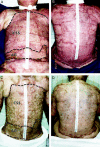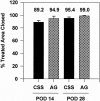Cultured skin substitutes reduce donor skin harvesting for closure of excised, full-thickness burns
- PMID: 11807368
- PMCID: PMC1422424
- DOI: 10.1097/00000658-200202000-00016
Cultured skin substitutes reduce donor skin harvesting for closure of excised, full-thickness burns
Abstract
Objective: Comparison of cultured skin substitutes (CSS) and split-thickness skin autograft (AG) was performed to assess whether donor-site harvesting can be reduced quantitatively and whether functional and cosmetic outcome is similar qualitatively in the treatment of patients with massive cutaneous burns.
Summary background data: Cultured skin substitutes consisting of collagen-glycosaminoglycan substrates populated with autologous fibroblasts and keratinocytes have been shown to close full-thickness skin wounds in preclinical and clinical studies with acceptable functional and cosmetic results.
Methods: Qualitative outcome was compared between CSS and AG in 45 patients on an ordinal scale (0, worst; 10, best) with primary analyses at postoperative day 28 and after about 1 year for erythema, pigmentation, pliability, raised scar, epithelial blistering, and surface texture. In the latest 12 of the 45 patients, tracings were performed of donor skin biopsies and wounds treated with CSS at postoperative days 14 and 28 to calculate percentage engraftment, the ratio of closed wound:donor skin areas, and the percentage of total body surface area closed with CSS.
Results: Measures of qualitative outcome of CSS or AG were not different statistically at 1 year after grafting. Engraftment at postoperative day 14 exceeded 75% in the 12 patients evaluated. The ratio of closed wound:donor skin areas for CSS at postoperative day 28 was significantly greater than for conventional 4:1 meshed autografts. The percentage of total body surface area closed with CSS at postoperative day 28 was significantly less than with AG.
Conclusions: The requirement for harvesting of donor skin for CSS was less than for conventional skin autografts. These results suggest that acute-phase recovery of patients with extensive burns is facilitated and that complications are reduced by the use of CSS together with conventional skin grafting.
Figures








Similar articles
-
Cultured skin substitutes reduce requirements for harvesting of skin autograft for closure of excised, full-thickness burns.J Trauma. 2006 Apr;60(4):821-9. doi: 10.1097/01.ta.0000196802.91829.cc. J Trauma. 2006. PMID: 16612303 Clinical Trial.
-
The 1999 clinical research award. Cultured skin substitutes combined with Integra Artificial Skin to replace native skin autograft and allograft for the closure of excised full-thickness burns.J Burn Care Rehabil. 1999 Nov-Dec;20(6):453-61. doi: 10.1097/00004630-199920060-00006. J Burn Care Rehabil. 1999. PMID: 10613682
-
Comparative assessment of cultured skin substitutes and native skin autograft for treatment of full-thickness burns.Ann Surg. 1995 Dec;222(6):743-52. doi: 10.1097/00000658-199512000-00008. Ann Surg. 1995. PMID: 8526581 Free PMC article. Clinical Trial.
-
Principles and practices for treatment of cutaneous wounds with cultured skin substitutes.Am J Surg. 2002 Apr;183(4):445-56. doi: 10.1016/s0002-9610(02)00813-9. Am J Surg. 2002. PMID: 11975935 Review.
-
Closure of the excised burn wound: autografts, semipermanent skin substitutes, and permanent skin substitutes.Clin Plast Surg. 2009 Oct;36(4):643-51. doi: 10.1016/j.cps.2009.05.010. Clin Plast Surg. 2009. PMID: 19793558 Review.
Cited by
-
Cellular human tissue-engineered skin substitutes investigated for deep and difficult to heal injuries.NPJ Regen Med. 2021 Jun 17;6(1):35. doi: 10.1038/s41536-021-00144-0. NPJ Regen Med. 2021. PMID: 34140525 Free PMC article. Review.
-
Successful management of deep facial burns in a patient with extensive third-degree burns: the role of a nanocrystalline silver dressing in facilitating resurfacing.Int Wound J. 2007 Mar;4(1):8-14. doi: 10.1111/j.1742-481X.2006.00263.x. Int Wound J. 2007. PMID: 17425544 Free PMC article.
-
Isolation and feeder-free primary culture of four cell types from a single human skin sample.STAR Protoc. 2022 Feb 10;3(1):101172. doi: 10.1016/j.xpro.2022.101172. eCollection 2022 Mar 18. STAR Protoc. 2022. PMID: 35199036 Free PMC article.
-
Stem Cell Therapies for Epidermolysis Bullosa Treatment.Bioengineering (Basel). 2023 Mar 27;10(4):422. doi: 10.3390/bioengineering10040422. Bioengineering (Basel). 2023. PMID: 37106609 Free PMC article. Review.
-
Comparison of combination skin substitutes and skin grafts versus skin grafts only for treating wounds measured by Vancouver Scar Scale: A comprehensive meta-analysis.SAGE Open Med. 2024 Aug 12;12:20503121241266342. doi: 10.1177/20503121241266342. eCollection 2024. SAGE Open Med. 2024. PMID: 39139266 Free PMC article. Review.
References
-
- Herndon DN, Muller MJ, Blakeney PE. Teamwork for total burn care: achievements, directions and hopes. In Herndon DN, ed. Total burn care. Philadelphia: WB Saunders; 1996: 1–4.
-
- Hansbrough JF, Dominic W, Gadd M, et al. Burns: critical decisions. Prob Crit Care 1987; 1: 558–610.
-
- Burke JF, Quinby WC, Bondoc CC. Early excision and prompt wound closure supplemented with immunosuppression. Surg Clin North Am 1978; 58: 1141–1150. - PubMed
-
- Hansbrough JF, Mozingo DW, Kealey GP, et al. Clinical trials of a biosynthetic temporary skin replacement, Dermagraft-TC compared to cryopreserved human cadaver skin for temporary coverage of excised burn wounds. J Burn Care Rehabil 1997; 18: 43–51. - PubMed
Publication types
MeSH terms
Grants and funding
LinkOut - more resources
Full Text Sources
Other Literature Sources
Medical

